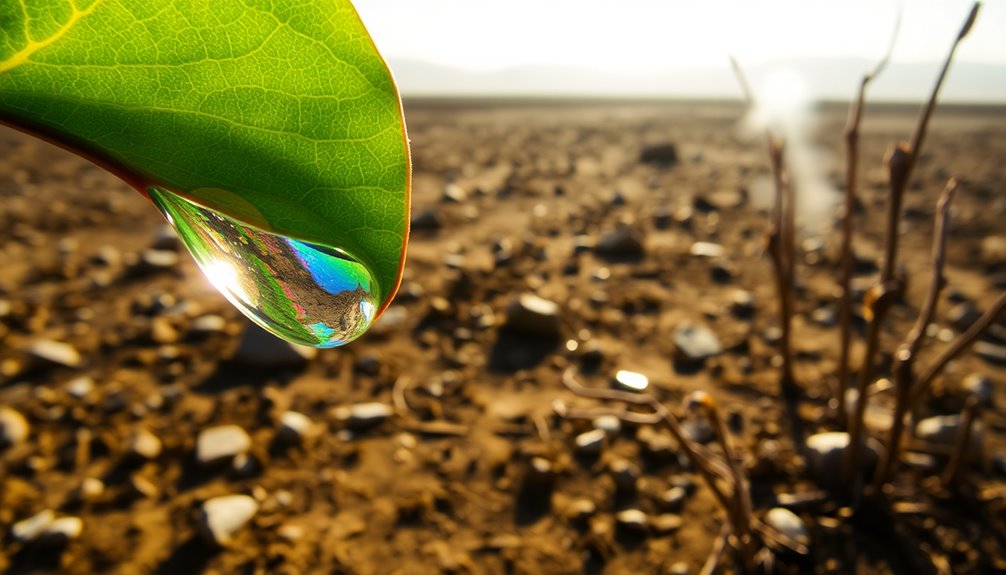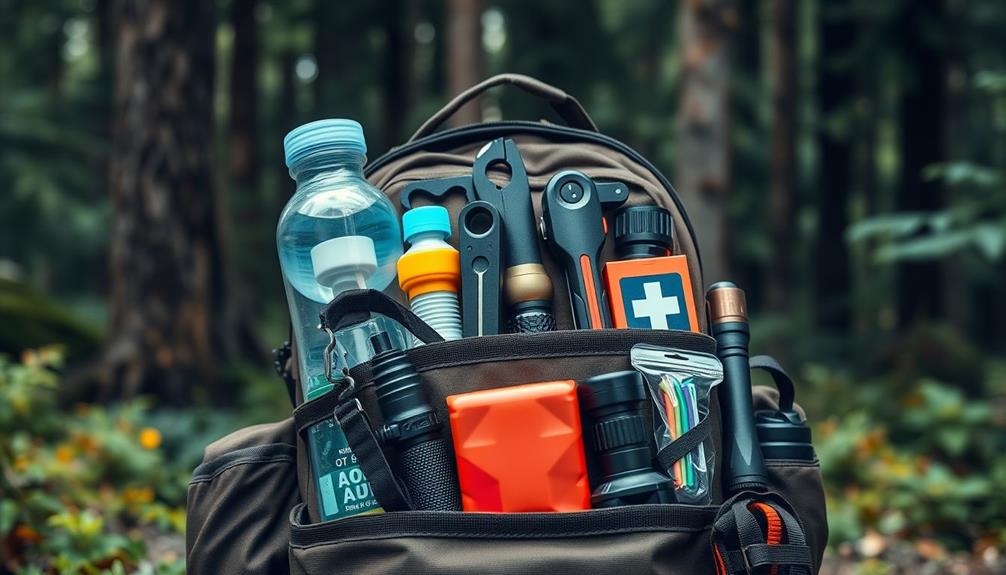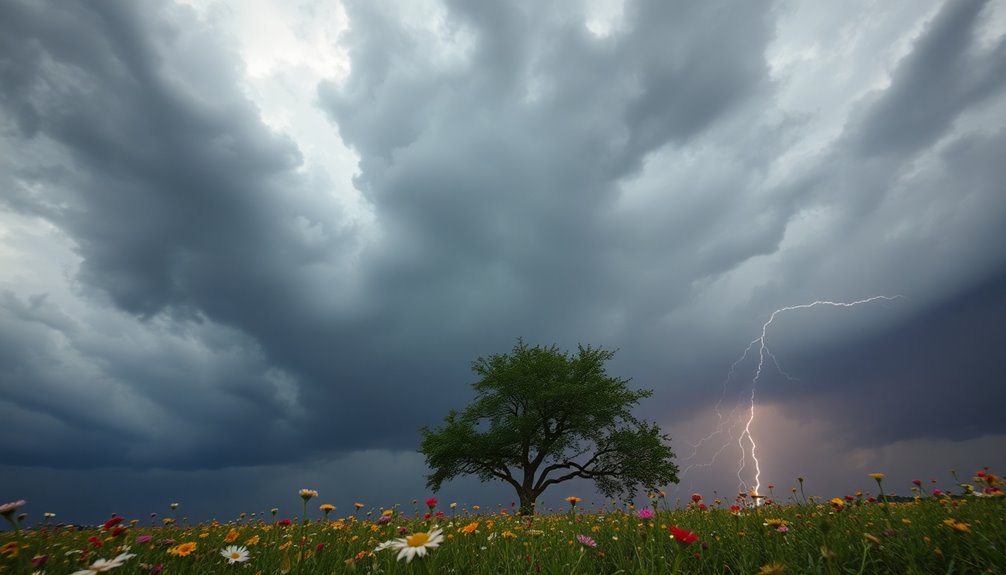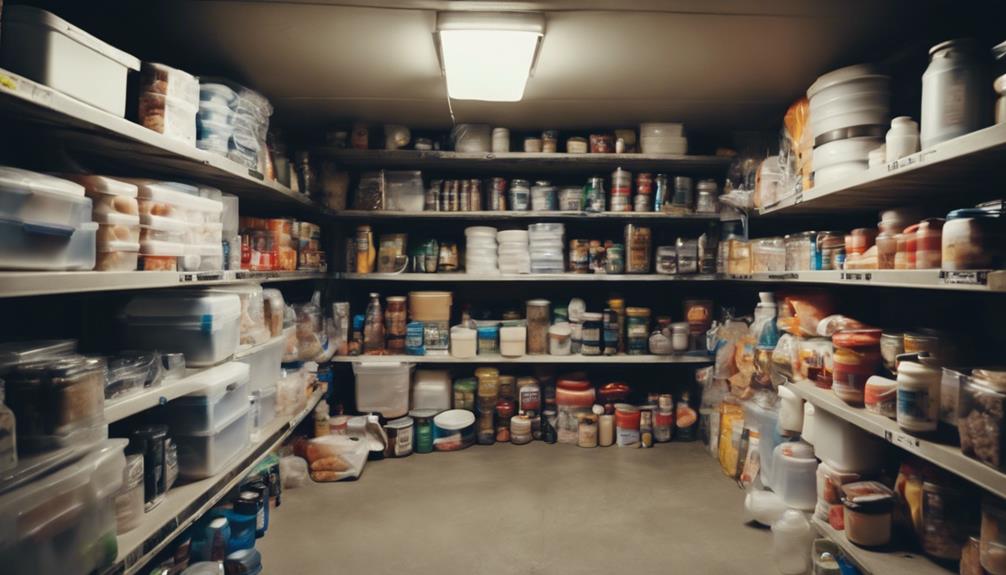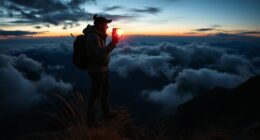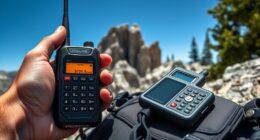Finding water in the wild isn't impossible if you know where to look. Start by exploring low-lying areas like valleys or ravines, as gravity gathers water there. Listen for trickling sounds; they can guide you to fresh sources. Keep an eye out for lush vegetation and animal tracks—they often point to water. You can also collect morning dew from plants or use clear plastic bags on leafy branches to gather moisture. Don't forget about building structures to catch rain. Mastering these tricks will keep you hydrated in the wild, and there's much more to discover about effective water sourcing techniques.
Key Takeaways
- Explore low-lying areas like valleys and ravines, where gravity often directs surface water accumulation.
- Utilize natural condensation by covering leafy branches with plastic to collect moisture overnight.
- Follow animal trails and observe lush vegetation, as they often lead to hidden water sources.
- Harvest dew from large-leaved plants early in the morning for a fresh water source.
- Implement rainwater harvesting techniques using containers or tarps to collect precipitation effectively.
Locating Surface Water Sources

When you're out in the wild, finding surface water sources is essential for survival, and there are several reliable ways to locate them. Start by exploring valleys, ravines, and other low points, as gravity pulls water to these areas. Look for rivers, streams, lakes, and wetlands, which can be perennial, ephemeral, or even artificial. Perennial sources are more reliable, especially during dry spells, while ephemeral sources, like small creeks, can dry up seasonally. Listen closely for the sound of trickling or rushing water—this auditory cue can guide you to a fresh source. If you find running water, head upstream for cleaner options. Additionally, check natural collectors like hollow stumps and depressions in rocks, which might hold water after rain. Remember that awareness of water sources can significantly improve your chances of survival in the wild.
Identifying Groundwater Indicators
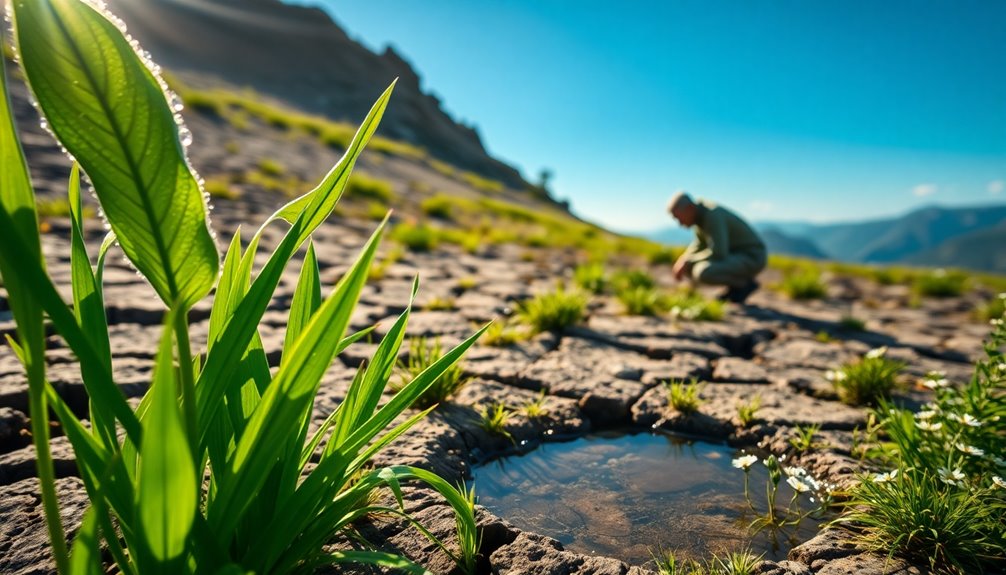
How can you effectively identify groundwater indicators in the wild? Start by looking for chemical indicators. Organic micropollutants can reveal contamination sources, such as agricultural or industrial activities. Using advanced tools like machine learning can help you pinpoint these pollutants, which could range from pharmaceuticals to pesticides. Recent studies have identified chemical indicators that can specifically highlight contamination sources across different regions.
Next, consider environmental tracers and isotopes. These tools can quantify groundwater flow rates and recharge, giving you insights into how water moves underground. Understanding residence times is essential for estimating the flow rates in your area.
Don't overlook hydrogeological indicators either. Evaluating aquifer conditions, like water quality and contaminant presence, can provide critical information. Consider legal indicators as well, focusing on state policies that affect groundwater governance.
Understanding Geology and Topography
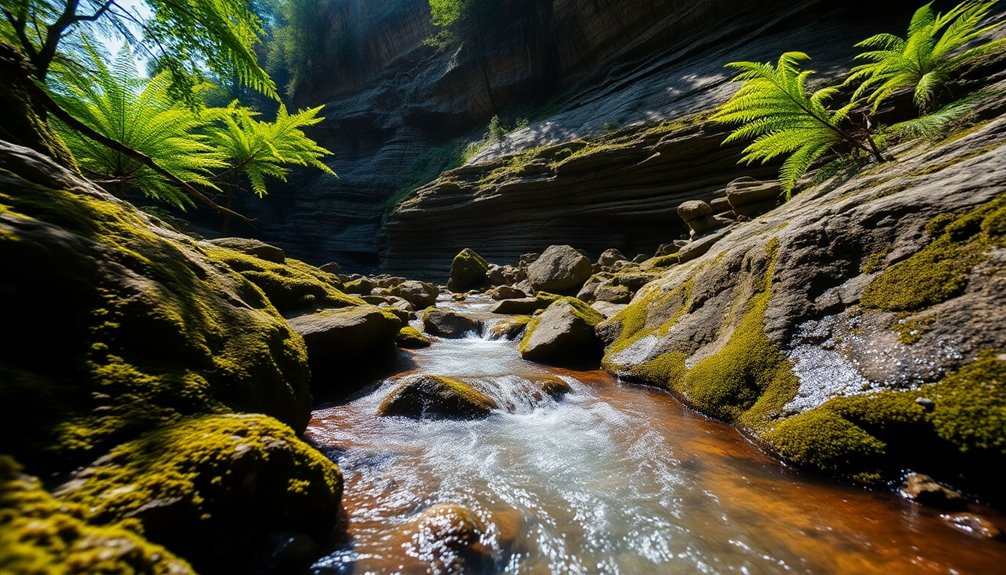
Understanding the interplay between geology and topography is vital for locating groundwater sources. Groundwater resides in the pore spaces and fractures of rock formations, with aquifers being the most productive bodies of porous rock or sediment. You'll find sedimentary formations—like those in river valleys—are generally more fruitful for groundwater than weathered crystalline rocks.
Pay attention to low-lying areas such as valleys and ravines; gravity causes water to accumulate in these spots. Groundwater-dependent ecosystems, including springs and wetlands, often thrive in these specific topographical settings. Elevation and slope also play important roles in how groundwater recharges and discharges, influencing local water cycles. Additionally, the vast majority of subsurface areas likely contain some water, which can further aid in locating groundwater sources.
To gauge groundwater availability, measure water levels in local wells and study geological records. Pumping tests can reveal an aquifer's flow characteristics. Remember, groundwater can take days to millennia to recharge, so understanding its residence time helps you assess its long-term availability. By grasping these geological and topographical factors, you greatly boost your chances of finding water when you need it most.
Modern Detection Techniques

When you're searching for water, advanced geophysical methods can greatly enhance your chances of success. Techniques like isotope tracing not only help you identify potential water sources but also provide insights into the water's age and origin. Understanding these modern detection methods can make all the difference in your quest for life-sustaining resources. Additionally, employing PQWT technology can significantly improve the accuracy and efficiency of locating underground water.
Advanced Geophysical Methods
Advanced geophysical methods are revolutionizing the search for water in the wild, offering precise techniques to explore subsurface conditions. By employing these modern detection techniques, you can greatly enhance your ability to locate water sources efficiently.
Here's a quick overview of some key advanced methods:
| Method | Description | Key Benefit |
|---|---|---|
| Caliper Logging | Measures borehole diameter for geometry assessment | Identifies borehole instability |
| Ground-Penetrating Radar (GPR) | Maps soil and rock stratigraphy | High-resolution water table mapping |
| Electrical Resistivity Imaging | Creates images of subsurface resistivity | Effective for groundwater mapping |
| Gamma Logging | Measures natural gamma radiation | Helps correlate rock layers |
| Borehole Deviation Logging | Records borehole geometry in 3D | Determines feature orientation |
Using these advanced methods, you can gather critical data about subsurface conditions, allowing for informed decision-making in your water exploration efforts. Effective water-resources management is essential for maximizing the potential of the insights gained through these advanced techniques. By combining techniques like GPR with electrical resistivity imaging, you'll get a thorough understanding of the landscape, steering you closer to hidden water resources in the wild.
Isotope Tracing Techniques
Isotope tracing techniques are gaining traction as powerful tools for locating water sources in the wild. You can leverage stable isotopes like heavy hydrogen and oxygen-18 to trace water movement through soils and streams, providing insights into where water is migrating. If you're interested in dating water sources, radioisotopes such as tritiated water can be invaluable.
Sampling methods have evolved considerably. You can use laser spectroscopy for a cost-effective, simultaneous analysis of hydrogen and oxygen isotopes. This method simplifies the process compared to more complex isotope-ratio mass spectrometers. Additionally, in-stream counters allow you to measure isotopes directly in water bodies without needing to collect samples.
Isotope tracing also helps in identifying water sources and evaluating groundwater contamination. For instance, you can differentiate between tap water and precipitation to understand water damage origins. While these techniques offer sensitive detection, keep in mind that regional variability and methodological challenges can limit their applications. However, recent technological advancements have enhanced the precision and efficiency of isotope measurements, making it easier than ever to find and study water sources in the wild. Furthermore, a comprehensive understanding of critical-zone processes is essential for effectively managing water resources in the face of climate change and population growth.
Collecting Water From Plants

To collect water from plants effectively, you'll want to focus on using non-toxic species with large, green leaves or berry bushes. This method harnesses the natural condensation process, allowing you to gather fresh water in the wild.
Here are some key points to keep in mind:
- Select the Right Plants: Look for plants that receive ample sunlight and have a high number of healthy leaves. Water-loving trees like willows can be particularly effective, as they are known for their ability to provide moisture in arid environments.
- Gather Your Materials: Use a clear plastic bag, string or wire, and small stones to secure your setup. A fabric like a t-shirt will help filter the water later.
- Set Up the Collection: Tie the bag tightly around a leafy branch, ensuring it hangs lower to capture the condensation.
- Be Patient: It usually takes about 3-4 hours to collect a decent amount of water, with larger droplets forming at the bag's lowest point.
Creating Effective Water Collection Structures

Creating Effective Water Collection Structures
After gathering water from plants, you'll want to explore more structured methods to collect water effectively in the wild. One of the most efficient ways is through roof-based rainwater harvesting. You can use galvanized iron sheets or clay tiles as your catchment area. Make certain to prepare your roof by covering thatch areas with waterproof sheeting and guaranteeing a gentle slope towards the downpipe.
The downpipe should be made from materials like bamboo or wood, and the gutter needs a slope to encourage water flow into your storage tank. A covered tank minimizes evaporation and allows sediment to settle, providing clear water for drinking.
Alternatively, consider ground-based microcatchments, which involve creating diamond-shaped basins with earth bunds to store runoff. Ascertain these bunds are compacted and protected from erosion with grass cover. Effective water harvesting techniques can significantly enhance water availability in arid regions.
For larger areas, external catchment systems like earth dams or ponds can effectively harvest rainwater. Remember to maintain these structures by cleaning and monitoring them regularly, especially before the rainy season, to prevent contamination and maximize your water collection efforts.
Utilizing Natural Water Traps

Utilizing natural water traps can greatly enhance your chances of finding water in the wild. By paying attention to your surroundings, you can identify potential water sources. Look for signs in the landscape and vegetation that indicate the presence of water.
- Seek out green vegetation and lush foliage; they often indicate nearby water sources.
- Follow animal tracks or trails; animals typically lead you to water.
- Observe grain-eating birds and swarming insects, as they tend to flock near water.
- Look for wet dirt or dry river beds, which can signal underground water.
You can also collect water from plants using techniques like leaf transpiration or squeezing fruits and cacti. Be cautious, though; identifying safe plants is essential to avoid poisonous species. Morning dew can also be collected, providing a revitalizing source of hydration. Additionally, remember that the average daily water intake recommended is 2-3 liters, emphasizing the importance of finding multiple sources to stay hydrated.
Essential Survival Tips for Water
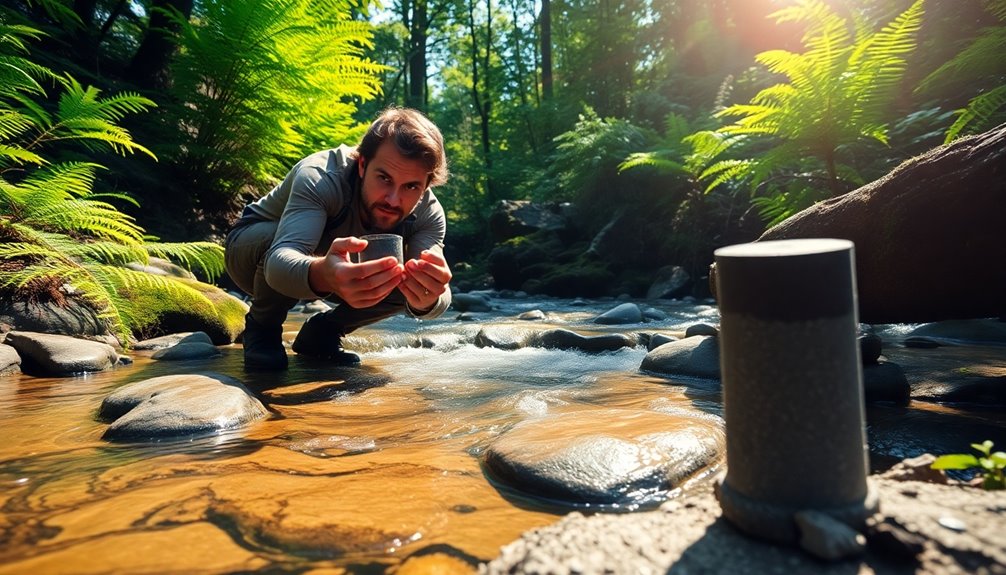
When you're in the wild, knowing how to identify natural water sources is essential for your survival. Look for streams, signs of wildlife, and lush vegetation as indicators of nearby water. Once you find it, use effective collection techniques to guarantee you gather enough to stay hydrated. Additionally, it's crucial to boil water for at least 10 minutes to ensure it is safe to drink, especially if the water source is uncertain. Understanding the importance of long-term survival foods can also aid in your overall preparedness when navigating through challenging environments.
Natural Water Sources
Finding water in the wild can be challenging, but knowing where to look considerably increases your chances of survival. Natural water sources are essential. Here are some key areas to search for:
- Rivers and Streams: Reliable but always purify before drinking.
- Lakes and Ponds: Often stagnant; purification is essential.
- Valleys and Ravines: Low areas where water collects due to gravity.
- Groundwater: Usually safe from bacteria but check for chemical pollutants.
Look for signs in the environment. Vegetation like willows and cattails often indicates nearby water. Morning dew on grass can also provide hydration. Follow animal tracks or game trails, as they often lead to water sources. Additionally, observe the landscape—wet dirt or dried riverbeds may hint at underground water. Remember that dehydration can impair judgment, so it's crucial to locate water sources as soon as possible.
Stay vigilant for life signs, such as swarming insects or algae, which suggest water is nearby and potentially safe. By honing in on these natural indicators, you greatly enhance your ability to find water in the wild, ensuring your survival and well-being in challenging conditions.
Water Collection Techniques
In the wild, knowing how to collect water can mean the difference between life and death. Start by collecting rainwater using any available containers. If you have a poncho or tarp, tie it between trees, placing a rock in the center to create a dip for water collection. Funnel the rainwater into a bottle or pot to maximize your haul, and make certain your system doesn't overflow. Just avoid urban areas due to pollution.
Next, gather morning dew by tying absorbent cloth around your ankles and walking through tall grass. You can also use a clear plastic bag over a leafy branch, sealing it tightly with a rock. This captures water from plant transpiration, so choose non-toxic plants to keep things safe. Water is essential for clear thinking and performing survival tasks, so prioritize these collection methods to stay sharp.
If you're near the beach, dig a well behind the first sand dune, lining it with rocks for stability. Cover it and check for fresh water after an hour. For a more advanced method, create an underground still with a container and clear plastic sheeting to collect moisture. These techniques can help guarantee you stay hydrated when nature is sparse.
Frequently Asked Questions
What Are the Safest Methods to Purify Collected Water?
To purify collected water safely, you've got a few solid options. Boiling is foolproof; just bring it to a rolling boil for at least one minute. If you prefer chemical treatments, iodine or chlorine can work, but remember to wait 20-30 minutes before drinking. Water filters are effective too, especially those with 0.22-micron pores. Using UV light purifiers is another choice, though they require batteries. Choose the method that best suits your situation!
How Can I Store Water for Long-Term Use?
To store water for long-term use, choose food-grade containers made of plastic, glass, or stainless steel. Make certain they’re clean and sanitized to avoid contamination. Store your water in a cool, dark place, sealing the containers tightly. Rotate your water supply every six months to maintain freshness, and regularly check for signs of cloudiness or discoloration. This way, you’ll guarantee your stored water stays safe and drinkable when you need it. Additionally, avoid common water storage mistakes such as using containers that previously held non-food items, as these can contaminate the water. It’s also important to label your water containers with the date they were filled and to keep track of when you need to rotate them. By staying vigilant and following these tips, you can ensure that your stored water remains safe and potable for use during emergencies or when access to clean water is limited.
What Types of Animals Indicate Water Proximity?
Picture a lush green area, where deer graze peacefully and birds like red-winged blackbirds flit about. These animals, along with raccoons and marsh wrens, often signal nearby water. You might notice deer following paths that lead to creeks or ponds, while smaller mammals, like squirrels, thrive in habitats close to moisture. Their movements and presence can guide you to hidden water sources, revealing nature's clues in the wilderness.
Can I Drink Seawater if I'm Desperate?
You shouldn't drink seawater, even if you're desperate. It's too salty and can lead to severe dehydration. When you consume it, your body tries to balance the salt levels by releasing water from your cells, which makes you thirstier. Instead of helping, drinking seawater can cause serious health issues like vomiting and confusion. In survival situations, always seek freshwater sources, as they're essential for your well-being. Stay safe and hydrated!
How Do Weather Conditions Affect Water Availability?
Weather conditions have a big impact on water availability. When precipitation patterns change, you might find yourself in a region with either too much water, leading to flooding, or not enough, causing drought. If you live in a semiarid area, reduced rainfall can mean constant water deficits. Additionally, extreme weather events like hurricanes or heavy storms can disrupt local water systems, affecting both quality and access. Adjusting to these changes is essential for maintaining water resources.
Conclusion
Finding water in the wild isn't just about survival; it's about hope, resilience, and ingenuity. You've learned to locate surface sources, identify groundwater, and understand the land around you. You've discovered techniques to collect water from plants and create effective structures. By utilizing natural traps, you're not just quenching your thirst; you're embracing the spirit of adventure. So, as you forge ahead, remember: every drop counts, every effort matters, and every moment brings you closer to safety.

